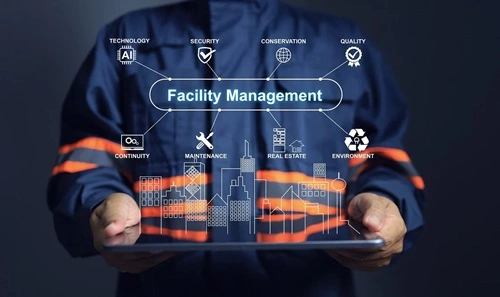Facility Management (FM) refers to the strategic planning, maintenance, and operation of buildings, infrastructure, and services to ensure smooth business operations. It encompasses multiple functions, including maintenance, security, safety, asset management, space utilization, and environmental sustainability.
In India, facility management is crucial in industries such as IT parks, manufacturing plants, corporate offices, healthcare institutions, educational institutions, and hospitality sectors. Companies like JLL India, CBRE, Knight Frank, and Sodexo provide professional facility management services to ensure operational efficiency.
While effective facility management improves workplace productivity, safety, and cost efficiency, it also has challenges such as high costs, operational complexities, and dependence on external service providers.
In this article, we explore the advantages and disadvantages of facility management, helping businesses understand its role in optimizing operations and maintaining infrastructure.
Quick Overview: Facility Management Advantages & Disadvantages

| Advantages | Disadvantages |
|---|---|
| Enhances Workplace Efficiency & Productivity | High Implementation & Maintenance Costs |
| Reduces Operational Costs & Energy Consumption | Requires Skilled Professionals & Workforce |
| Ensures Safety, Security & Compliance | Complexity in Managing Large Facilities |
| Improves Asset Management & Equipment Lifespan | Dependence on Third-Party Service Providers |
| Supports Environmental Sustainability & Green Initiatives | Technology & Software Implementation Challenges |
| Enhances Employee & Visitor Satisfaction | Unforeseen Facility Issues Can Disrupt Operations |
Advantages of Facility Management
1. Enhances Workplace Efficiency & Productivity
Effective facility management ensures that employees have a well-maintained, safe, and comfortable work environment, leading to:
- Higher employee satisfaction and reduced absenteeism.
- Efficient space utilization and office layout optimization.
- Improved collaboration and workflow efficiency.
For example, IT companies like Infosys and TCS use facility management to create ergonomic office spaces that boost employee productivity.
2. Reduces Operational Costs & Energy Consumption
Facility managers optimize energy usage and reduce operational expenses through:
- Smart building management systems (BMS).
- Energy-efficient lighting, HVAC systems, and water-saving techniques.
- Preventive maintenance to avoid expensive repairs.
For example, hospitals implementing energy-efficient cooling systems can reduce electricity bills by up to 20%.
3. Ensures Safety, Security & Compliance
Facility management includes safety protocols, fire prevention, and compliance with government regulations, ensuring:
- Adherence to building safety standards and legal requirements.
- Implementation of emergency evacuation plans.
- Protection of employees, assets, and visitors.
For instance, malls and multiplexes in India use FM teams to ensure fire safety, CCTV monitoring, and crowd control.
4. Improves Asset Management & Equipment Lifespan
A well-managed facility increases the lifespan of critical assets, such as:
- Elevators, HVAC systems, and electrical infrastructure.
- Manufacturing equipment and IT hardware.
- Office furniture and shared workspaces.
For example, factories with scheduled maintenance programs experience fewer machinery breakdowns and higher efficiency.
5. Supports Environmental Sustainability & Green Initiatives
Modern facility management incorporates sustainable practices to:
- Reduce carbon footprint and water wastage.
- Improve waste management and recycling.
- Promote green buildings and eco-friendly workspaces.
For example, the Infosys campus in Bangalore has LEED-certified green buildings with solar energy and rainwater harvesting systems.
6. Enhances Employee & Visitor Satisfaction
Facility management ensures that offices, hotels, and public spaces provide:
- A clean and organized environment.
- Well-maintained restrooms and common areas.
- Efficient parking management and accessibility.
For example, corporate offices with well-maintained cafeterias and recreational areas improve employee morale.
Disadvantages of Facility Management
1. High Implementation & Maintenance Costs
Facility management requires significant financial investment in:
- Infrastructure upgrades and maintenance.
- Facility management software and automation tools.
- Hiring and training facility management professionals.
For instance, maintaining a high-rise commercial building involves annual expenses for HVAC servicing, elevator maintenance, and security systems.
2. Requires Skilled Professionals & Workforce
Managing large facilities needs experienced professionals and trained technicians, including:
- Building maintenance engineers and energy auditors.
- Security personnel and housekeeping staff.
- IT professionals to manage facility software systems.
For example, hospitals require specialized facility managers to maintain sterile environments, medical equipment, and patient safety standards.
3. Complexity in Managing Large Facilities
Facilities with multiple departments, floors, and branches require:
- Advanced coordination between teams and service providers.
- Efficient scheduling of cleaning, maintenance, and security operations.
- Constant monitoring to ensure smooth workflow.
For example, managing an airport facility involves coordination between airlines, security agencies, baggage handling, and passenger services.
4. Dependence on Third-Party Service Providers
Many organizations outsource facility management services to external vendors, which can lead to:
- Quality control issues if the vendor is inefficient.
- Delays in response times for maintenance issues.
- Security risks if proper background verification is not conducted.
For example, outsourcing security services in corporate offices requires strict background checks and contractual agreements to prevent breaches.
5. Technology & Software Implementation Challenges
Modern facility management relies on advanced technology, including IoT sensors, AI-driven maintenance systems, and automated scheduling tools, which require:
- High initial investment in software and infrastructure.
- Employee training on using facility management software.
- Integration with existing building management systems.
For example, smart cities implementing automated traffic control and waste management systems face challenges in software integration and scalability.
6. Unforeseen Facility Issues Can Disrupt Operations
Even with well-planned facility management, unexpected issues like power outages, water leaks, and equipment failures can disrupt business operations.
- Emergency repairs lead to unplanned expenses.
- Downtime affects productivity and customer satisfaction.
- Legal liabilities may arise from safety hazards.
For example, a power failure in a data center can lead to server downtime, affecting IT operations and business continuity.
Who Should Invest in Facility Management?
Best Suited For:
✔ Large corporate offices managing multiple floors and departments.
✔ IT parks, hotels, hospitals, and shopping malls requiring round-the-clock maintenance and security.
✔ Manufacturing industries that need strict equipment maintenance and safety compliance.
✔ Government institutions, airports, and educational campuses with high footfall and facility needs.
Not Suitable For:
✘ Small businesses with simple infrastructure and limited maintenance needs.
✘ Startups with low office space requirements and remote work models.
✘ Organizations with budget constraints preventing investment in facility management tools.
Conclusion: Is Facility Management Essential for Business Success?
Facility Management (FM) is a critical function that enhances workplace efficiency, safety, and sustainability. It ensures that businesses operate smoothly, reduce operational costs, and improve employee and customer experiences.
However, FM requires significant investment, skilled professionals, and continuous monitoring to be effective. Businesses must weigh the costs and benefits of in-house facility management versus outsourcing to specialized service providers.
For large enterprises, manufacturing units, and commercial properties, facility management is essential. However, smaller businesses with minimal infrastructure needs may find simpler maintenance solutions more cost-effective.
Anantha Nageswaran is the chief editor and writer at TheBusinessBlaze.com. He specialises in business, finance, insurance, loan investment topics. With a strong background in business-finance and a passion for demystifying complex concepts, Anantha brings a unique perspective to his writing.


